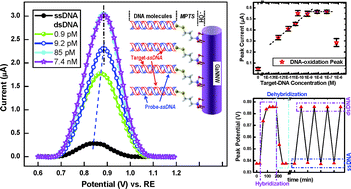This study demonstrates the utility of functionalized GaN nanowires (GaNNWs) for electrochemical detection of nucleic acids, in aqueous solution, using cyclic voltammetry. In order to link probe DNA to the NW surface, we employed an organosulfur compound, 3-mercaptopropyl trimethoxysilane (MPTS), to functionalize the GaNNW surface. Interestingly, the MPTS-modified GaNNWs exhibited a potential window of 4.5 V, the widest reported to date, with very low background current, which provides an advantage for sensing DNA immobilization/hybridization, down to sub-pM concentration, via monitoring adenine and guanine oxidation. The oxidation of guanine was characterized by its peak potential and peak current, where the former serves as a fingerprint for DNA hybridization and the latter as a parameter for the extent of hybridization. Moreover, the GaNNW-based sensor exhibited excellent consistency in hybridization-dehybridization-rehybridization cycles.
You have access to this article
 Please wait while we load your content...
Something went wrong. Try again?
Please wait while we load your content...
Something went wrong. Try again?


 Please wait while we load your content...
Please wait while we load your content...